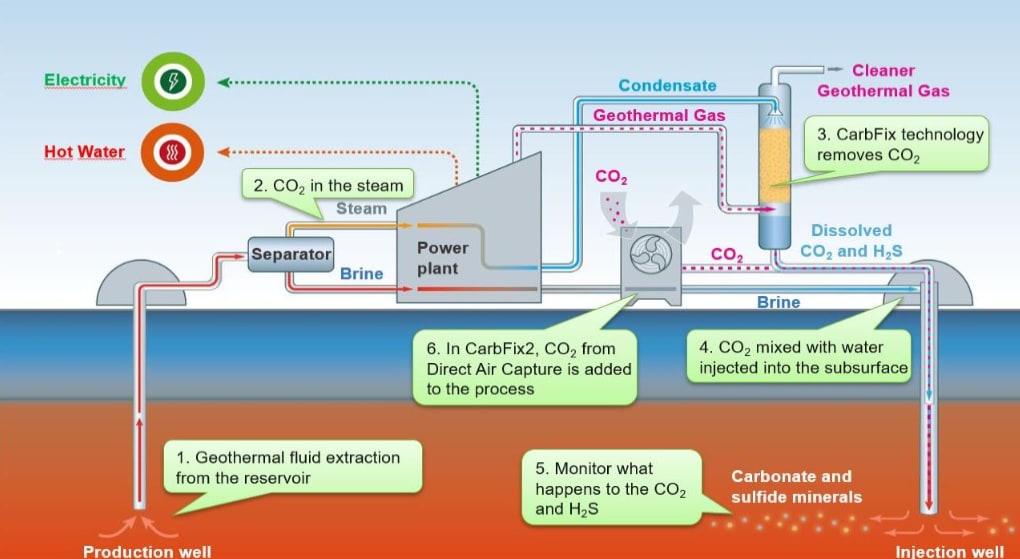How Iceland's Carbfix Project is turning carbon dioxide into rock

CarbFix project – fixing CO2 into rock
Image: CarbFix
Stay up to date:
Climate Crisis
- The CarbFix project has been capturing emissions from power plants and sequestering them into rocks.
- The project began in 2012 when researchers and engineers began sequestering carbon into basalt rocks in southwest Iceland.
- It's a collaboration between Reykjavik Energy, the University of Iceland, France’s National Centre for Scientific Research (CNRS) and Columbia University in the US.
The climate change clock is ticking. In 2018, global carbon emissions reached a record high and the United Nations warned we could have just 12 years left to prevent the catastrophic effects of climate change. Since then, the UK and Irish parliaments have declared climate emergencies.
While countries are making the shift towards clean energy, few are decarbonizing fast enough to meet the 2016 Paris Agreement climate targets. With time running short, some scientists have been working on other ways to mitigate global warming, including capturing carbon emissions from power plants and industrial processes and then sequestering them safely underground.
Carbfix project: from CO2 to minerals
In 2012, a team of international researchers and engineers began injecting carbon dioxide (CO2) into porous basalt rock, formed from cooling lava, at an underground test site in southwest Iceland.
Two years later, almost all of the CO2 had morphed into carbonate minerals.
The team’s breakthrough, reported in the journal Science in 2016, led to the scaling up of the CarbFix project – fixing CO2 into rock, literally – at the Hellisheidi geothermal power station, about 30 kilometers from the the Icelandic capital of Reykjavik.
The CarbFix project – a collaboration between utility company Reykjavik Energy, the University of Iceland, France’s National Centre for Scientific Research (CNRS) and Columbia University in the US – has been capturing and injecting about a third of the CO2 and three-quarters of the hydrogen sulfide emitted from Hellisheidi.
Thanks to its volcanic geology, Iceland has enormous geothermal resources that can be harnessed to produce clean energy. Heating and hot water for most Icelandic homes and more than a quarter of the nation’s electricity comes from geothermal energy.
Hellisheidi is located on the Hengill volcano, on top of a layer of basalt rock. Water underneath the volcano is pumped up to run six turbines, which provide electricity and heat to the capital city as a part of the CarbFix project.
Though than energy produced from fossil fuels, geothermal plants emit some CO2, as well as the hydrogen sulfide contained in steam.
In a process project director Edda Sif Aradottir describes as "making soda water", the CO2 from the steam is captured and dissolved in large amounts of water. This fizzy water is then pumped to the injection site, where chemical reactions convert the CO2 into minerals. Trapped in rock, the CO2 can't leak out of the ground and into the atmosphere.
Can Carbfix work elsewhere?
Basalt formations are found around the world and the CarbFix team believe their model could be repeated elsewhere. The process does, however, require large amounts of desalinated water – about 25 tonnes of water per tonne of stored CO2 – so they are working on adapting it to saltwater.
"Basalt is actually the most common rock type on Earth, it covers most of the oceanic floors and around 10% of the continents. Wherever there's basalt and water, this model would work,” Sandra Osk Snaebjornsdottir, a geologist working for CarbFix, told the BBC.
The UN’s Intergovernmental Panel on Climate Change wants to see wider adoption of models like CarbFix that remove CO2 from the atmosphere, known as carbon capture and storage (CCS) and negative emissions technologies (NETs).
However, while such technologies can contribute to the fight against climate change, implementing them at scale is likely to be difficult and expensive. Experts say approaches like CarbFix are “no silver bullet”, and people should still be making more of a daily effort to reduce emissions.
Don't miss any update on this topic
Create a free account and access your personalized content collection with our latest publications and analyses.
License and Republishing
World Economic Forum articles may be republished in accordance with the Creative Commons Attribution-NonCommercial-NoDerivatives 4.0 International Public License, and in accordance with our Terms of Use.
The views expressed in this article are those of the author alone and not the World Economic Forum.
Related topics:
Forum Stories newsletter
Bringing you weekly curated insights and analysis on the global issues that matter.
More on Climate ActionSee all
Sebastian Buckup and Beth Bovis
July 10, 2025
Majlinda Bregu
July 9, 2025
Tom Crowfoot
July 8, 2025
Duncan Wood
July 8, 2025
Sam Markey, Basmah AlBuhairan, Muhammad Al-Humayed and Anu Devi
July 8, 2025







